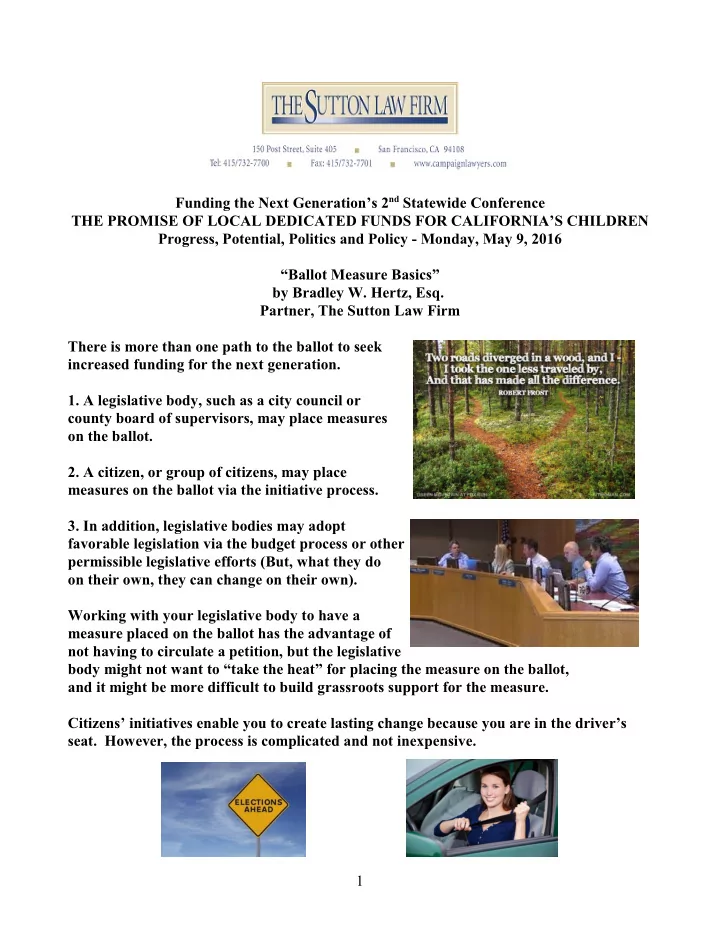

Funding the Next Generation’s 2 nd Statewide Conference THE PROMISE OF LOCAL DEDICATED FUNDS FOR CALIFORNIA’S CHILDREN Progress, Potential, Politics and Policy - Monday, May 9, 2016 “Ballot Measure Basics” by Bradley W. Hertz, Esq. Partner, The Sutton Law Firm There is more than one path to the ballot to seek increased funding for the next generation. 1. A legislative body, such as a city council or county board of supervisors, may place measures on the ballot. 2. A citizen, or group of citizens, may place measures on the ballot via the initiative process. 3. In addition, legislative bodies may adopt favorable legislation via the budget process or other permissible legislative efforts (But, what they do on their own, they can change on their own). Working with your legislative body to have a measure placed on the ballot has the advantage of not having to circulate a petition, but the legislative body might not want to “take the heat” for placing the measure on the ballot, and it might be more difficult to build grassroots support for the measure. Citizens’ initiatives enable you to create lasting change because you are in the driver’s seat. However, the process is complicated and not inexpensive. 1
Initiative Ground Rules: Keeping it legal What is an initiative? An initiative is a legislative act that is proposed by citizens, printed on a petition, circulated among the jurisdiction’s voters, and submitted to the government entity to be adopted or placed on the ballot. Initiatives are a constitutional right in California and are jealously guarded by the courts. An initiative is required to: 1. Be a legislative, and not an administrative, act. 2. Be constitutional. 3. Embrace a single subject. 4. Contain its “full text.” 5. Be specific and not vague. An initiative is not allowed to: 1. Merely direct the legislative body to perform a legislative act. 2. Be preempted by federal or state law. 3. Impair essential government functions. 4. Regulate in an area that has been exclusively delegated to a legislative body. 5. Name a private entity to perform a function or have any power or duty. 6. Impair contracts. 7. Be arbitrary and discriminatory. 2
Components of an Initiative Proponent(s) Title (Your Title vs. the Official Title) Notice of Intent and Statement of Reasons Findings and Declarations Purposes and Intent Definitions Substantive Provisions (including where you want to place the new law into the existing law). New language is usually underlined and in italics. Language to be deleted is in strikeout format. Seek the right balance between simplicity and complexity. Liberal Construction Conflicting Measures Effective Date Sunset Provision Severability Amendment and Repeal Ability to Defend the Initiative 3
Further “Food for Thought” 1. Surround yourself with knowledgeable people (attorneys, political consultants, political treasurers, petition circulation experts, et al.) 2. Build alliances and marshall your resources. 3. Be realistic about what you can and cannot accomplish. 4. Do not underestimate the substantial task you are undertaking. 5. Do not underestimate the complexity of election law requirements (California Elections Code, California Government Code, Political Reform Act, Local Laws, etc.) 6. Think about potential pitfalls, litigation, competing ballot measures, etc. 7. Don’t “reinvent the wheel.” 8. Enjoy the democratic process! 4
Recommend
More recommend